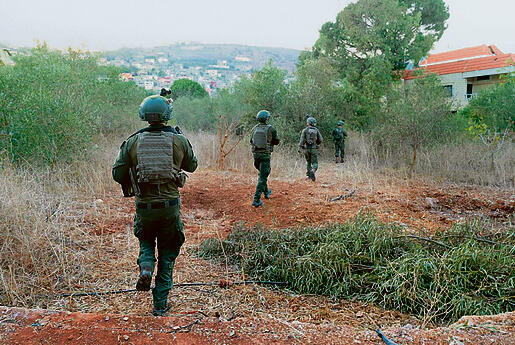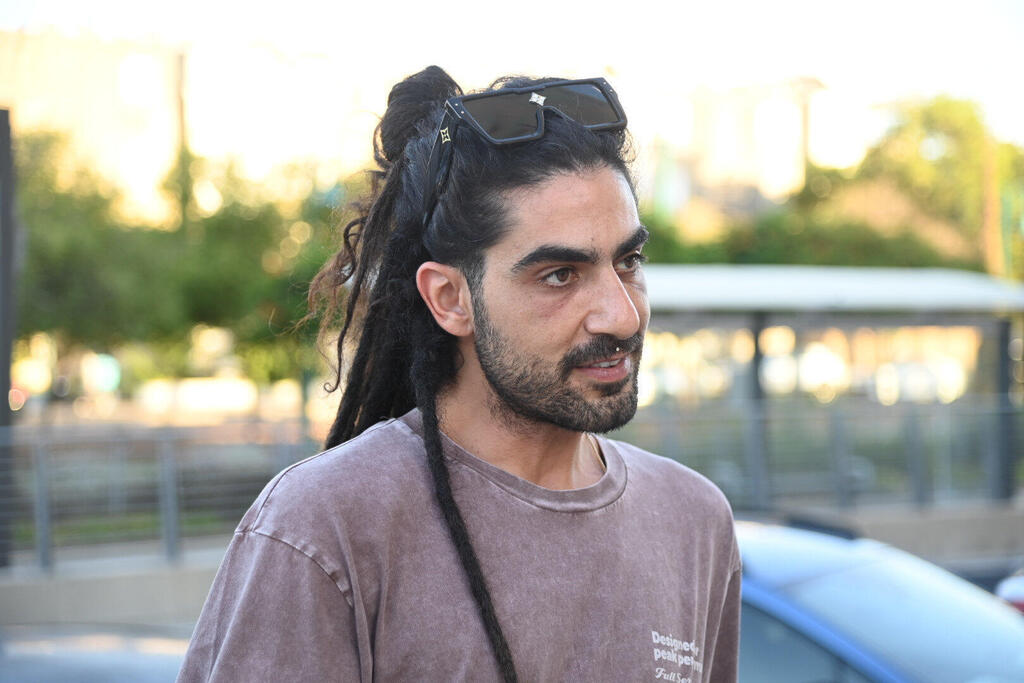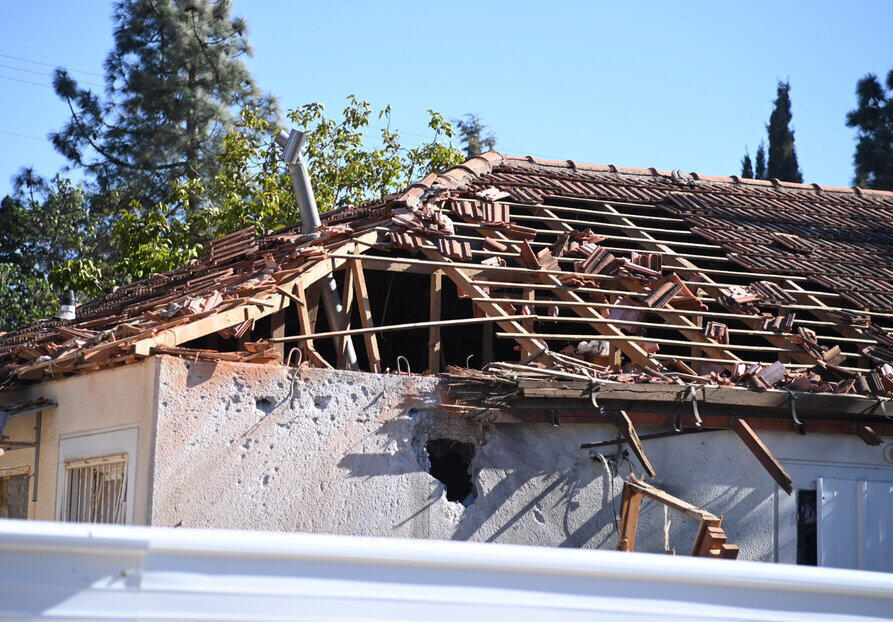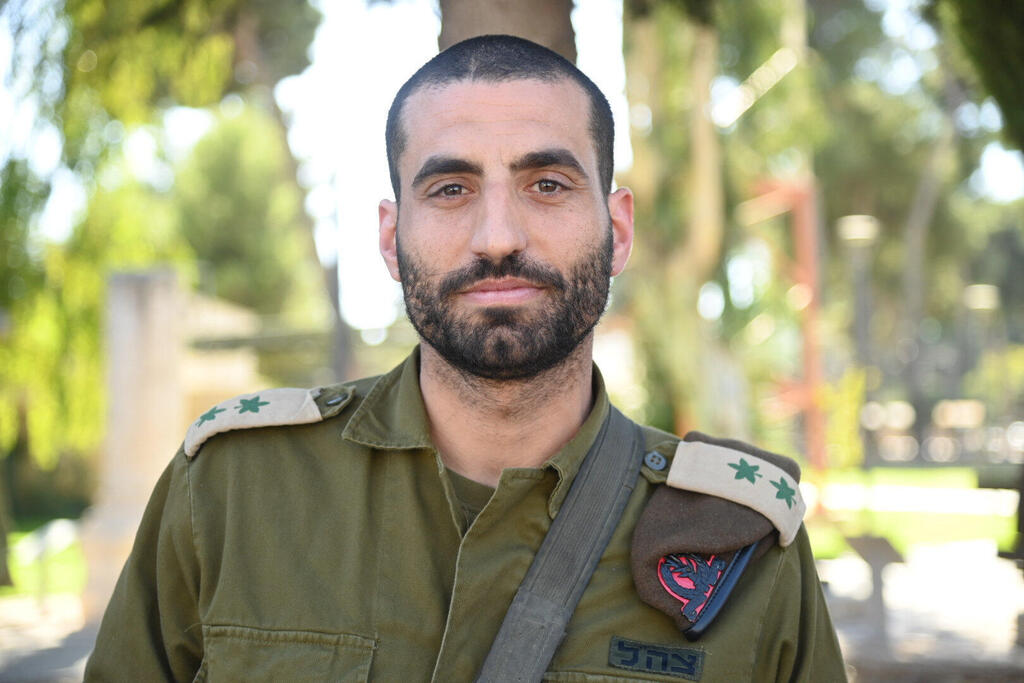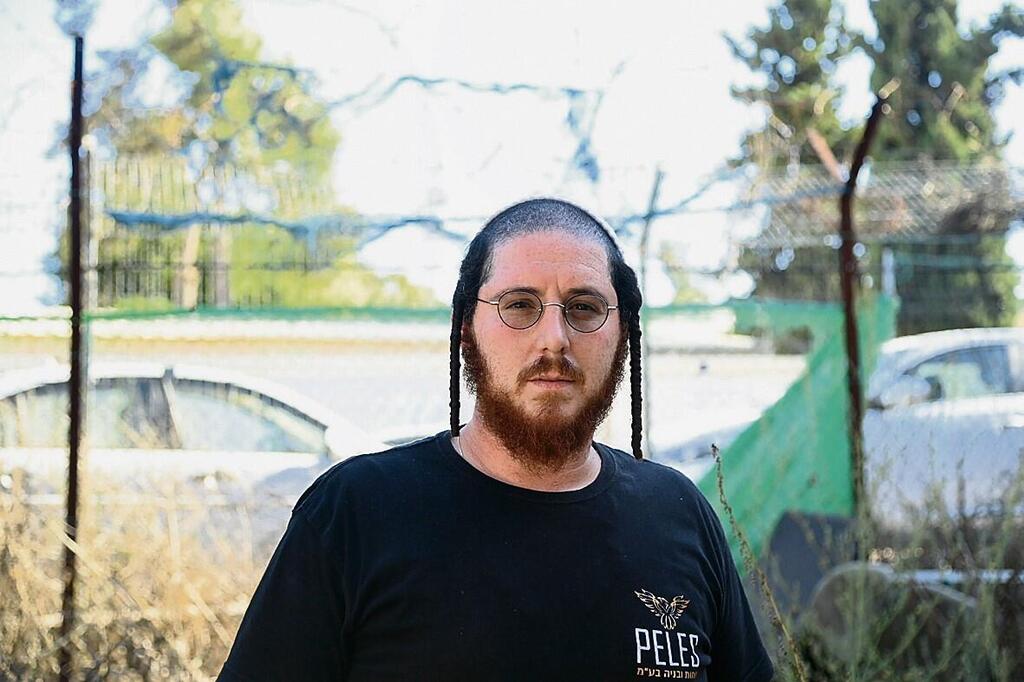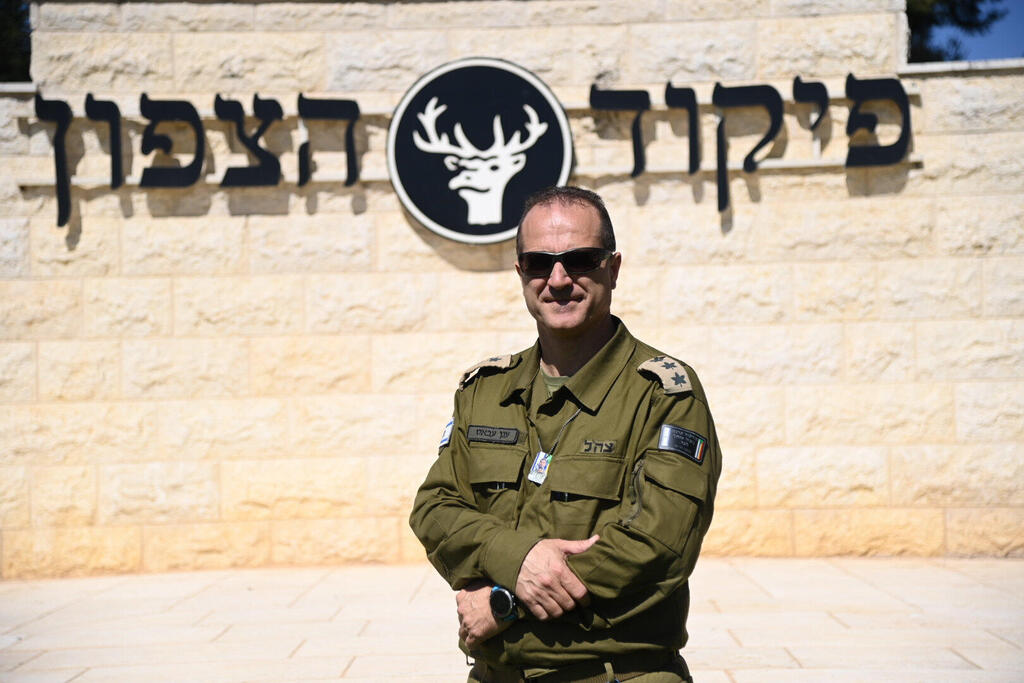Getting your Trinity Audio player ready...
A little caption appeared on one of the screens at 12:11 p.m. reading, “Kiryat Yam, Kiryat Haim and Shmuel, Haifa – Bay.” This was followed by a string of further alerts in Kiryat Motzkin, Kiryat Bialik, Haifa – West, Haifa – Carmel, and the Home Front Command sending automated messages online and onto apps.
This is a great drama for those suddenly hearing the sirens wailing, quickly getting themselves to shelters and hearing explosion blasts, interceptions and crashes. But here, in the earth’s belly in the Northern Command pit, this is yet one more incident occurring in tandem with several dozen others.
The wall facing dozens of people sitting deep within Mount Canaan is covered with a huge screen divided into dozens of squares, with something going on in each square. Remotely manned aircraft escorting the ground forces in Lebanese territory are broadcasting the live, up-to-date picture. Each force has its own aircraft escorting it in the sky, so you can simultaneously view several broadcasts from different battle sites.
The digital map displays the forces’ locations and movements, and on the adjacent screen, a real-time update of the evacuation of wounded soldiers from inside Lebanon, bringing them for medical treatment in Israel. What’s going on on the home front, is another piece of the puzzle - a piece for which the Home Command is responsible.
A few hours later, at one of the crash sites in Kiryat Yam, you realize the huge discrepancy between the calm composure required in the bunker in Safed, a site protected from attack allowing people down there to carry on running the war, and the fear and anxiety that comes with hearing the sirens outside.
There’s a little screen in the command pit broadcasting a Hebrew TV channel, the channel switching every few minutes. It’s on mute, and you just see the pictures from the crash site, interviews with dazed residents and the images of the damage and destruction.
On another screen, an Israeli Air Force (IAF) aircraft follows a vehicle traveling on a dirt path somewhere in southern Lebanon, driving through orchards, turning left and carrying on straight. And the black and white picture, constantly homing in on it, momentarily making you forget about the drama that very moment in Haifa Bay.
Only when we see the little small shopping center on the corner of Jerusalem and Jabotinsky Boulevards, and with our own eyes, see the torn blinds, shattered windows and air-conditioning units torn off buildings, do we understand what happened here. A rocket that landed on the roof of Birkat Moshe bakery, has torn a hole through a layer of concrete and iron bars. Dozens of windows are shattered, and air-conditioning units torn off three buildings above the shopping center.
The bakery owner, Eliran Assouline, says that he heard three consecutive sirens. “Our safe room is at the back, inside the kitchen. We all got in. As soon as the sirens stopped, instead of waiting for ten minutes, I went out to check, and then I heard a huge explosion followed by a blast and I was hurled into the air.”
Meir Ohayon, who owns the Beshem Ha’omanut tattoo parlor, a smiley guy with Rastafarian locks and a big tattoo of Salvador Dali on his arm, saw Assouline go flying. “What’s that flying? I saw him hit by the biggest blast ever. He was like a meter into the air and two meters back. Like in the movies, he left the ground and went flying. I was just running to the shelter when the missile hit the roof and there was a massive explosion. Everything went black, the concrete went flying, and bits of plaster were flying around. There was loads of smoke. It was crazy I tell you.”
Haka's hill
Not far from the pit, stands a battered old Willys jeep that served Maj. Gen, Yitzhak (Haka) Hofi, commander of the Northern Command in the Yom Kippur War. The base commander was then stationed in the fortress building in Nazareth (which now serves as the police’s northern HQ), too far away from the IDF’s battles staving off Syria’s surprise invasion of the Golan Heights.
Back then, there weren’t any LED screens or planes remotely controlled from a hundred miles away from the front, broadcasting pictures of the war. Hofi had to jump into the jeep and find a position from which he could see the Golan Heights, and manage the front from there. Mt. Canaan above Safed was the perfect spot.
Brig. Gen. (res.) Shuki Shahrur, 67, was only a 16-year-old boy at the time, but later enlisted and advanced in the army, serving as an operations officer, staff wing officer and the Northern Command’s chief of staff. In the past 20 years, he’s spent more time at the command base in Safed than at home.
Following the 1973 war, it was decided to transfer the command headquarters from Nazareth to Mt. Canaan,” he says. “I watched all the work setting up the command pit. They dug deep down into the mountain and inserted kilometers of electric cables, air and water pipes. They started in 1979 and finished 11 years later. I had the honor of being the first to operate the pit as the command’s operations officer. Knowing this pit extremely well, I can say that it’s constantly undergoing the most advanced technological adjustments.”
"Down there, there’s a dining room, a gym, a clinic, a synagogue, and barracks. These are huge spaces, interconnected by corridors, and in the central areas, you can see the side of the mountain into which this complex was dug. Independent energy centers are allowing for command continuity if, Heaven forbid, the whole business above ground is out of use.”
None of this guarantees anything, certainly not winning the war. Impressive as this place might be, it’s merely a technical matter allowing for ongoing management of this long war, with no end in sight. Almost all of the Hezbollah leadership has been assassinated.
Radwan, Hezbollah's offensive force, has been severely hit, and the IDF is attacking from the air in Beirut and Bekaa, and on the ground in Lebanon. Four divisions have been assigned to the limited ground operation in southern Lebanon - a huge force of 11 brigades including six reservist brigades.
And still, when we went down into the pit, sirens were sounding across the Galilee. Hezbollah is keeping up its missile and rocket firing capabilities, averaging 200 launches per day, enough to completely disrupt daily life.
Fighter jets on standby
We were asked to wait in a side room. Defense Minister Yoav Gallant was just arriving for a visit. He sat down in front of a wall of screens, waited for his team to set up a camera who then filmed a video clip, later disseminated to all news outlets.
“Hezbollah is an organization with no head,” he said as those present watched the screens. “Nasrallah has been assassinated, probably his successor too. A year into the war, and Hamas has been taken apart, Hezbollah a battered organization.” Two hours later, over 100 rockets were launched at Haifa and the Bay Area.
But at the end of the day, when we put aside these boisterous statements, the technology and this impressive installation, we’re left with people. People keep up a calm professional atmosphere, even with a firestorm raging outside.
When one of the forces encounters a Hezbollah cell in a village in Lebanon, Lt. Col. Yuval Mazuz, the command’s operations officer, oversees managing the incident. We have two terrorists killed, and two of our forces wounded, requiring immediate evacuation. “Immediate evacuation” means that the injury’s severity is moderate and up.
A tank covers the evacuation while a remotely controlled aircraft covers all of this from the air. There’s also a combat helicopter not far, in case they need to launch a missile, and at the upper level, there’s also a fighter jet ready to drop heavier munitions.
Mazuz assumed the position in July 2023. Just before going down into the command pit in Safed, he passed the command baton for the Golani Brigade’s 13th Battalion onto his colleague, the late Lt. Col. Tomer Greenberg.
“Passing over the role between two battalion commanders is a very intimate matter,” he says. “You sit down with your successor for hours on end, sharing commitments about personnel scheduling, dilemmas, and your experiences commanding the battalion. We had plenty of meetings talking about the complexities around family life, about how you’re hardly home.”
Then came October 7. The war caught the 13th Battalion in operations in the Gaza border region, where the Nahal Oz outpost is located. The battalion lost 41 officers and soldiers in Hamas’ surprise attack and the battles they fought reconquering the outposts and communities. The battalion wasn’t broken, and Greenberg prepared it for ground operations inside Gaza. Greenberg was killed in Shijaiyah just before 6 p.m. on December 12. Nine more officers and soldiers fell alongside Greenberg, including two company commanders from the brigade.
At the time, Mazuz was in the command pit in the north in consultations with the general. “I left my phone above, so I couldn’t be contacted. It then turned out that the brigade had been trying to get hold of me. They also called my wife to find me and she sent me loads of WhatsApp messages for me to get back to her,” he said.
Mazuz was in Gaza by midnight of that day. His temporary appointment as company battalion carried into two and a half months, during which time he fought in Shijaiyah and the refugee camps in central Gaza. When appointed as permanent battalion commander after Greenberg was killed, he asked to focus on the fighting in Lebanon. “This is what I’m dealing with right now,” he says. “Defeating our enemy.”
Thirty seconds to get to a shelter
As these lines are written, the north is still being bombarded. A little after one o’clock in the afternoon, sirens are again sounding in Haifa and the Bay Area. Shortly thereafter, the IDF spokesperson announced that two civilians were killed by a rocket in Kiryat Shmona.
The command base has also been struck. Last February, a rocket hit the base, killing lookout Staff Sgt. Omer Benjo. There were almost daily sirens in Safed. The city itself is of no interest to Hezbollah. Their target is the command center. Improbable as it may sound, despite the city being targeted in the Second Lebanon War by Hezbollah’s efforts to hit the Northern Command base, Safed is not prepared for rocket fire, and most of the homes do not have safe rooms.
'If you’d have told me before that this is how much Hezbollah manages to fire, while the IDF is conducting ground operations in its territory, killing its men and severely damaging its infrastructure, commanders and arsenals, I’d have said you were on drugs.'
Yitav Haddad, whose home is on the command fence on Netz Street, lives in a home with a wife, three children and no safe room. The neighborhood bomb shelter is over 30 seconds’ run away with three toddlers.
“We live over the pit,” he says, pointing at the home’s floor. “No one thought to protect us. The Home Front Command toured the neighborhood and one of the officers said that we deserve three mobile shelters. That was over a month ago. As you see, this road hasn’t been given even one mobile shelter. I invite you to come stay with us and wait for the siren. Maybe a rocket or fragments from an interception will crash down, and then you’ll feel how our house shakes, nearly falling from the force of the blasts.”
Mazuz explains about proportion. “I’m not playing down 200 rockets fired a day. This is clearly serious, and we can’t reconcile ourselves to it. But we must remember what the predictions were for a war with Hezbollah. Our estimates were for a much more massive, broader and deeper fire. If you’d have told me before that this is how much Hezbollah manages to fire, while the IDF is conducting ground operations in its territory, killing its men and severely damaging its infrastructure, commanders and arsenals, I’d have said you were on drugs.”
Maj. Gen (res.) Annan Abbas, control wing chief in the command pit, wants us to take some air for a moment. We met him after he’d finished managing an incident in which a Hezbollah drone hit a border outpost in the Margaliot sector, injuring four soldiers.
“Listen, carefully,” he says. “I live in the area. I was born and raised here and, as a local, I know how much the residents by the border area are afraid of Hezbollah’s capabilities. Whenever the army sends up flares suspecting an infiltration, the local people panic. Every incident on the fence makes the local people panic. The Radwan Force has put out propaganda videos, done stunts on motorbikes, and threatened to conquer Galilee. In practice, the very opposite has happened. Radwan forces fled, retreated from the confrontation line and we’re in their houses, destroying them at every altercation.”
'Commander, this is Dad'
Abbas certainly is a character. The guy’s a Sphynx. He sits at the central post in the pit with special sports glasses protecting his left eye, injured during his service in the Druze Special Forces. Not a muscle in his face moved as the communication systems simultaneously relayed a series of different dramatic incidents in various sectors along the border fence.
He's 51, from Peki'in. His wife, Layla, is the village high school’s principal. Their eldest son, Gideon, was a squad commander in the elite Egoz Unit and was discharged following a severe training injury. He has since been serving as a reservist with his father in the command pit.
His middle son Jamal served commanding the Paratroopers’ 101st Battalion’s 3rd company. He’s an impressive, good-looking guy. His father proudly shows me pictures on his phone.
On the eve of the war, Jamal surprised his family, by coming home for short leave. He went out with his friends to Tiberias on Friday night and stayed over to sleep at one of their homes. The following day, when Hamas took Israel by surprise on the Gaza border, Annan, the father, quickly donned his uniform and rushed to the command pit in the north. “That’s my go-to response in an emergency,” he says. “Putting on my uniform, and going down to my post in the command pit.”
7 View gallery


Maj. Gen (res.) Annan Abbas ׂ(center) in the Northern Command pit
(Photo: IDF Spokesperson's Unit)
He didn’t get a chance to see his son come home, pack his bag,s and rush down south where he joined the battles fighting Hamas terrorists. Just before he set out, the young, 17-year-old daughter, Mirelle photographed him. Standing at the doorway, she caught him arranging his bag on his back. He’s already got his gun on him. The mother, with her back to the camera, is watching him get ready. Moments later he was in his car and off.
Three weeks later, the evening before going into Gaza, on October 29, Jamal called his father. “It was 1:30 a.m. I’d just come back from the command center,” the father says.
“Jamal sounded excited. He said they were about to go in, and that he was sending a message to the soldiers’ parents telling them this is a just war, and that he’ll do everything to protect their children, his soldiers. He told me something that rings in my head to this day. 'Dad, this is an existential war for the country, and in existential wars, people get killed, and maybe I won’t return from this war. And if I don’t come back, you must be proud of me.' I’m having this conversation at 1:30 a.m. after a long day in the pit.
"I answered. 'Forget your nonsense. Take care of yourself and your soldiers. There are a lot of tunnels beneath your feet in Gaza. Don’t be reckless,' I said to him. 'Don’t be reckless' because I know him. He had no fear. My boy was a galloping horse, a spirited fighter. He calmly answered, 'Dad, I understand the situation. I have a D9 and I have tanks. I have dogs and I have the Air Force. We’ll do everything slowly. I’ve promised their parents to bring their children back healthy and in one piece.”
Explosives and mines located by troops in South Lebanon
The days passed, and reports of the bitter battles in the Gaza Strip at the start of the ground operations wracked the father’s nerves. He tried getting hold of Jamal on Vered Harim, the IDF’s encrypted phone, but he wasn’t answering. He tried contacting his son’s command post by walkie-talkie – to no avail.
They made contact on November 15, Wednesday evening. “I was just about to leave the pit for home with my son Gideon, and two guys suddenly called me. ‘Hang on, one minute, we’ve got a surprise for you. You’re now going to talk to Jamal on the walkie-talkie.’ He was in some hole in Gaza and we were in a bunker underneath Safed. The conversation was published a few days later, by which time the family was in mourning.
Annan: “Commander, this is Dad.”
Jamal: “Continue.”
Annan: “Dad and Gideon send you their love. You are the fighters’ spearhead. Take care of yourselves. Strike Hamas. Destroy them. Fight fiercely, and wisely. Respond faster than the enemy. Stay there inside as long as it takes, until victory. We miss you and love you very much. Come back in peace. We, the Northern Command and your family, support you. Look after yourselves. Come back in peace. We’ll see you.”
Jamal: “Thank you very much.”
Annan: “Thank you, thank you. Take care of yourself. We’ll be in touch.”
Jamal: “No problem, dear father.”
Three days passed and, during a shift in the pit on Saturday, the Northern Command chief Ori Gordin’s secretary came in and asked him to accompany her. “I was in my spot,” he says, pointing at his post in the pit – the control officer’s position.
"She comes in and tells me, ‘The general wants you to go to his office.' It’s one floor above us, here in the pit. She said he wanted to consult with me. ‘I don’t know what it’s about.’ When I went into his room, he immediately got up, came up to me, and hugged me saying, ‘I’m sorry to tell you that Jamal was killed in clashes in Sheikh Ijlin in Gaza.’"
We stood at his position in the pit in silence. What’s left to say in such a situation?
The screen was displaying a big slide reading “situation picture.” A tear drew out of his healthy eye. The screen to the side read “12:45 – Kiryat Bialik Industrial Zone.”
Get the Ynetnews app on your smartphone:



